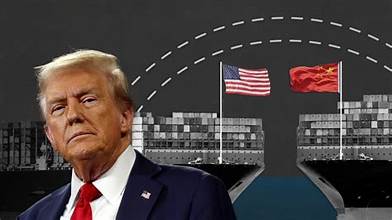‘Yippy’ and ‘Afraid’: What to know as Trump reverses course on tariffs
WASHINGTON – A week after announcing global “Liberation Day” tariffs and sending the world’s financial markets into a nosedive, President Donald Trump said Wednesday he’s pausing the reciprocal tariffs for 90 days for most countries with one notable exception.
Trump raised tariffs on China, one of America’s biggest trading partners and economic rivals, from 104% to 125%, saying the country would realize that “ripping off the U.S.A. … is no longer sustainable or acceptable.”
The moves marked a dramatic reversal after Trump vigorously defended the steep tariffs amid the economic and market upheaval.
Following the abrupt shift Wednesday, stocks skyrocketed and bond yield jumped.
Here’s what to know about Trump’s sudden pause:
Which tariffs were paused and which remain?
While hiking China’s tariff rate to a massive 125%, Trump paused what his administration has called “reciprocal tariffs” on imports from more than 70 other countries worldwide. These tariffs went into effect Wednesday, only hours before Trump halted them.
Trump said he is significantly lowering these tariffs to a 10% flat rate, matching the 10% baseline universal tariff that kicked in Saturday.
Previously imposed 25% tariffs on certain goods from Mexico and Canada, which weren’t part of last week’s reciprocal tariff rollout, will remain in place.
The pause also does not extend to industry-specific tariffs that Trump imposed on steel, aluminum and auto imports – nor would it apply to tariffs on pharmaceuticals, which Trump said are forthcoming.
Why did Trump back down?
Trump and his top economic advisers said they were swayed to pause the tariffs after more than 75 countries approached the U.S. seeking trade deals in the days after he unveiled them.
Trump, speaking to reporters, added that the changes were also prompted by people becoming concerned about turbulence in the markets. Economists and business leaders have increasingly warned that Trump’s aggressive tariffs could trigger a potential recession.
“I thought that people were jumping a little bit out of line,” Trump said. “They were getting yippy, you know. They were getting a little bit yippy, a little bit afraid.”
Two days ago, Trump said he wasn’t considering pausing the tariffs. And hours before his abrupt turnabout, Trump urged Americans to “BE COOL!”
Nonetheless, White House press secretary Karoline Leavitt accused the media of failing to grasp what Trump was trying to accomplish with the tariffs.
“Many of you in the media clearly missed the ‘Art of the Deal,’” she said, referencing the book that lifted Trump to national fame years ago. “You clearly failed to see what President Trump is doing here. You tried to say that the rest of the world would be moved closer to China, when in fact, we’ve seen the opposite effect the entire world is calling the United States of America.”
What’s the status of the US trade war with China?
While Trump’s pause calmed economic relations with much of the world, the escalating U.S.-China trade war showed no signs of abating.
China raised tariffs on U.S. exports on Wednesday from 34% to 84% in response to Trump’s additional 50% tariff on Chinese imports that kicked in when the day began.
In response to China’s latest countermeasure, Trump said he is increasing the tariffs on imports from China to 125%.
The U.S. goods trade deficit with China was $295.4 billion in 2024, a 5.8 percent increase ($16.3 billion) over 2023, according to the Office of the U.S. Trade Representative.
Earlier in the day, the European Union said it would impose 25% retaliatory tariffs on a range of U.S. exports in a first round of countermeasures to respond to Trump’s tariffs on steel and aluminum. The new EU tariffs remain in effect.
What were Trump’s ‘Liberation Day’ tariffs?
Last week, Trump announced a 10% baseline universal tariff on all imports and additional higher individualized tariffs on goods from dozens of countries.
Trump said he would charge countries a “discounted” reciprocal rate “because we are being very kind,” announcing tariffs that ranged from 10% to 49%.
While some nations faced a universal baseline tariff of 10%, countries such as Cambodia were hit with a 49% tariff. Thailand came in at 36%.
Trump had long ago hailed the announcement of his tariffs as “Liberation Day.” He also compared the trade tactic to surgery as he delivered a positive prognosis in the White House Rose Garden.
“I think it’s going very well. It was an operation, like when a patient gets operated,” he said on April 3, adding that the move was already bringing in close to $7 trillion in investments from companies wanting to bring companies to the U.S..
What’s next for negotiations with other nations?
Treasury Secretary Scott Bessent said about 75 countries have contacted the Trump administration looking to negotiate.
“Many of our trading partners have queued up and kept their cool and not escalated. They will get priority in the queue,” he said. “You are going to see some very large countries with large trade deficits come forward very quickly.”
The treasury secretary said several countries have accumulated these “gigantic surpluses” over the years, making it clear that the imbalances are either from tariffs or other protectionist policies.
Bessent said the U.S. and other allies could approach China about a potential trade deal after the Trump administration reaches agreements with Japan, South Korea and other countries on tariffs.
In remarks to the American Bankers Association’s summit, Bessent sounded optimistic. “At the end of the day, we can probably reach a deal with our allies, with the other countries they’ve been good military allies, not perfect economic allies – and then we can approach China as a group,” he said.
___________
USA TODAY









